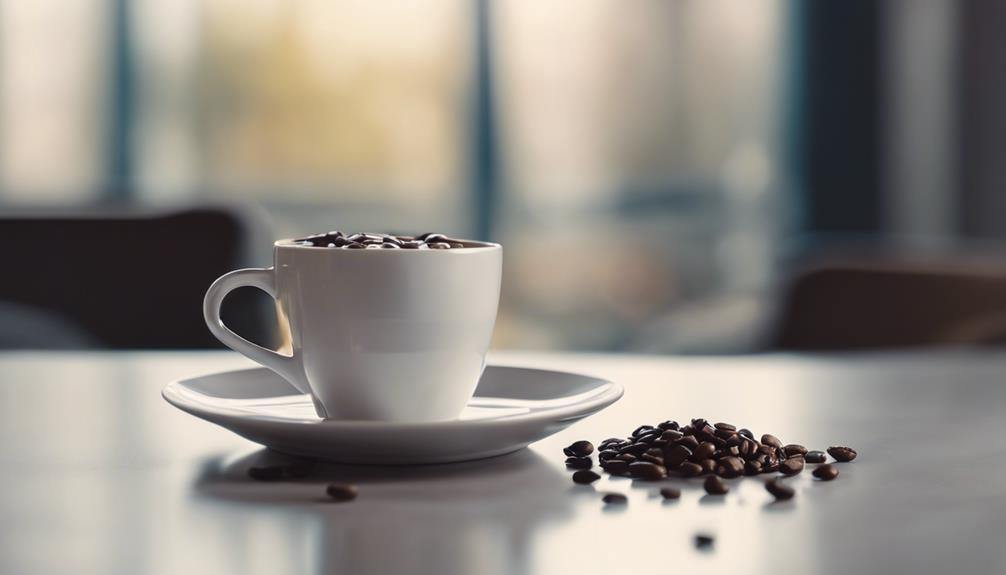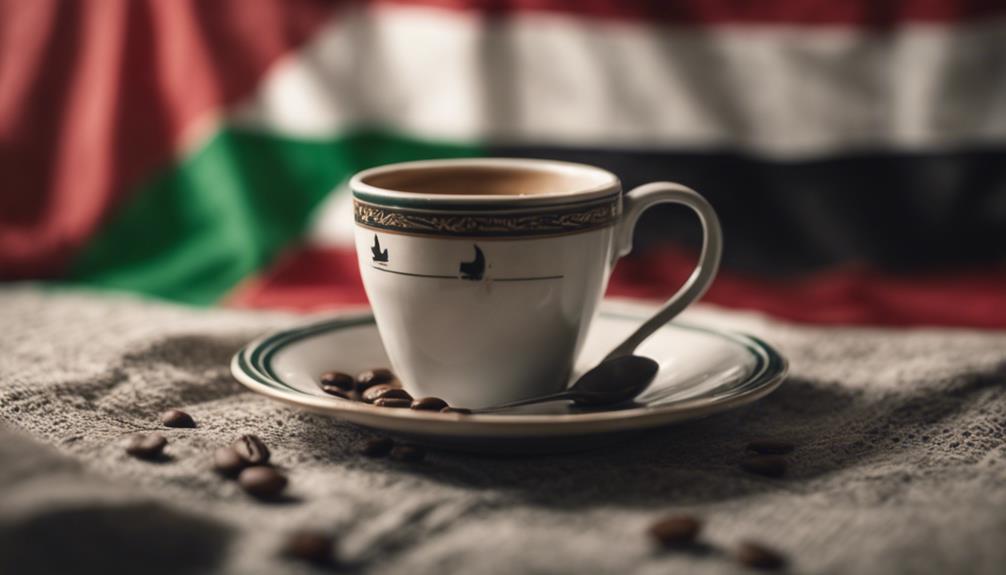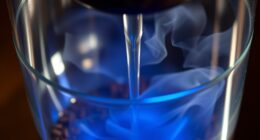You can have coffee while wearing Invisalign, but it’s crucial to prevent staining and warping of your aligners. The porous material of the trays makes them susceptible to discoloration, and tough coffee stains can be difficult to eliminate. To reduce the risk of staining and damage, it is recommended to remove your trays before drinking coffee, choose cold brew or dark roast, and use a straw. Following these steps will help you enjoy your coffee while keeping your Invisalign trays looking their best. For optimal results, familiarize yourself with caring for your aligners and coffee consumption guidelines.
Key Takeaways
• Remove Invisalign trays before drinking coffee to prevent staining and warping.
• Opt for iced or cold brew coffee to minimize warping of aligners.
• Use a straw when drinking hot coffee to minimize contact with trays.
• Rinse mouth and clean Invisalign trays after consuming coffee to remove residue and prevent stains.
• Limiting hot coffee intake or switching to lukewarm coffee can preserve tray appearance and prevent deformation.
Coffee Stains on Invisalign Aligners
One cup of coffee can leave more than just an energizing buzz, as its dark pigments and acidity can also stain your Invisalign aligners. You mightn't think twice about sipping a morning cup of joe, but it can have unintended consequences for your orthodontic treatment.
The porous nature of Invisalign trays makes them more prone to discoloration from coffee, which can lead to stubborn stains that are difficult to remove without proper cleaning. What's more, coffee stains on Invisalign may affect the overall appearance and visibility of the aligners, which can be frustrating for those who value discreet orthodontic care.
To prevent staining, it's essential to take proactive measures. Regularly rinsing your aligners and avoiding coffee consumption with trays in can help prevent staining.
Removing Trays Before Drinking Coffee

Before you take a sip of coffee, remove your Invisalign trays to prevent unwanted stains and damage. This simple step will help maintain the clarity of your aligners and keep your teeth looking their best.
| Benefits | Description |
|---|---|
| Remove Stains | Prevents unwanted coffee stains on your Invisalign trays |
| Maintain Clarity | Keeps your aligners clear and transparent |
| Reduce Damage | Minimizes the risk of damage to your Invisalign trays |
| Clean Aligners | Helps guarantee your aligners stay clean and free from discoloration |
| Healthy Teeth | Helps uphold healthy teeth and gums by preventing bacterial buildup |
Safe Coffee Options for Invisalign

When exploring safe coffee options for Invisalign, you'll want to take into account the type of coffee you drink and how you drink it. If you prefer to drink black coffee without any sugar or milk, then it is generally considered safer for Invisalign as it reduces the risk of staining. However, if you typically add cream or sweeteners to your coffee, you may want to limit your intake or brush your teeth immediately after. Another option is to use a straw when drinking coffee to minimize contact with your teeth. this way you can safely drink coffee after wisdom teeth.
You'll find that certain coffee options, such as cold brew and dark roast, are better suited for Invisalign wearers due to their lower acidity and staining potential.
Coffee and Aligners
When you're craving a cup of coffee while wearing Invisalign, selecting the correct type is important to minimize staining and damage to your aligners. You can still enjoy your daily coffee, but it's vital to take precautions to protect your Invisalign trays.
To guarantee safe coffee consumption, consider the following:
- Opt for cold brew or iced coffee: These options are less acidic and smoother, reducing the risk of staining.
- Use a straw: This will help prevent direct contact between the coffee and your Invisalign aligners.
- Rinse your Invisalign: After drinking coffee, rinse your aligners with lukewarm water to remove residue and staining agents.
- Choose dark roast coffee: Dark roast coffee has fewer staining agents, making it a better choice for Invisalign wearers.
Stain-Free Coffee Options
Opting for stain-free coffee options can make all the difference in protecting your Invisalign aligners from discoloration. As a coffee lover wearing Invisalign, you don't have to give up your daily cup of joe, but you do need to make informed choices.
| Coffee Option | Staining Potential | Why It's a Good Choice |
|---|---|---|
| Cold Brew | Low | Less acidic and smoother, reducing staining agents |
| Dark Roast | Low | Fewer staining agents compared to lighter roasts |
| Iced Coffee | Low | Less likely to stain due to lower acidity |
Hot Beverage Precautions
You can enjoy your daily coffee while protecting your Invisalign aligners by taking precautions with hot beverages. Since hot beverages like coffee can potentially warp your Invisalign trays over time, affecting their fit and effectiveness, it's essential to take extra care.
Here are some hot beverage precautions to keep in mind:
- Opt for lukewarm or cold coffee: Avoid extremely hot temperatures that can warp your Invisalign trays.
- Choose iced or cold-brewed coffee: These options reduce the risk of warping or staining your Invisalign aligners.
- Use a reusable straw: This helps protect your Invisalign trays from discoloration while drinking coffee.
- Rinse with lukewarm water: After consuming coffee, rinse your mouth and aligners with lukewarm water to maintain their appearance and integrity.
Caring for Your Invisalign Trays
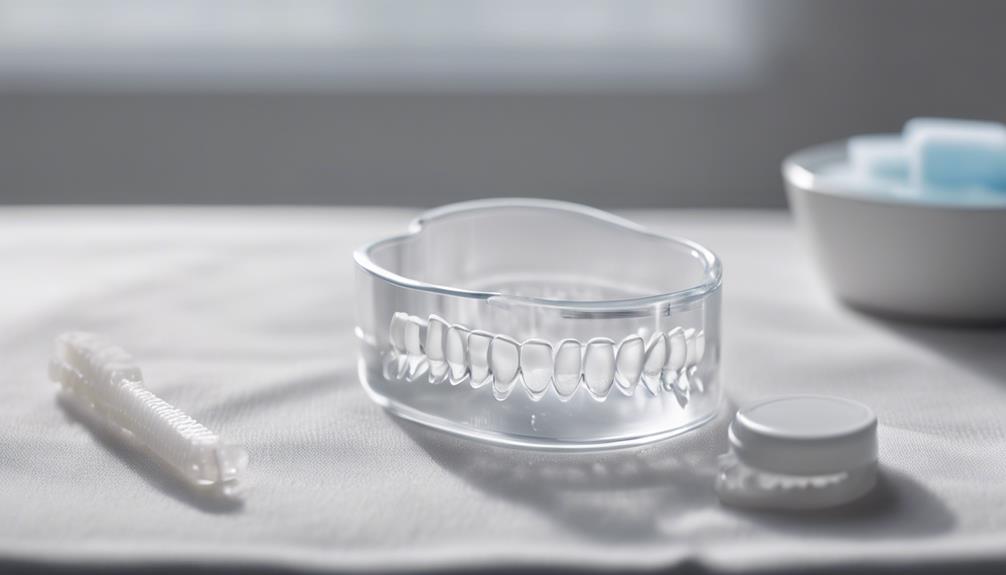
To maintain the top condition of your Invisalign trays, it's important to clean them thoroughly after drinking coffee to prevent staining and plaque buildup.
When you drink hot beverages like coffee, you should rinse your mouth thoroughly to protect both your teeth and aligners. Afterward, clean your Invisalign trays with lukewarm water to remove any residue and maintain their appearance.
You should also brush your teeth regularly to prevent any food particles or coffee stains from affecting your trays. It's important to prioritize the care of your Invisalign trays, as hot beverages can warp them over time.
By taking these precautions, you can prevent discoloration and damage to your aligners. Remember, proper care and cleaning of your Invisalign trays after drinking coffee is crucial to maintaining their effectiveness and extending their lifespan.
Coffee and Invisalign Treatment Times

Within the 15-30 minute window, it's important that you enjoy your coffee while wearing your Invisalign trays to minimize any potential impact on your treatment timeline. This allows you to indulge in your morning coffee habit without compromising your Invisalign treatment.
To guarantee the best results, it's crucial to understand how coffee consumption fits into your treatment schedule.
Here are some key considerations to keep in mind:
- Coffee breaks won't derail your treatment: Enjoying coffee within the recommended timeframe won't have a major impact on your Invisalign treatment progress.
- Wear your clear aligners for at least 20-22 hours: Make sure to wear your Invisalign trays for the recommended daily duration, even when enjoying coffee.
- Adjust your coffee habits to accommodate your treatment: Be mindful of your coffee consumption to ensure it doesn't disrupt your treatment schedule.
- Keep your teeth and trays clean: Rinse or brush your teeth after drinking coffee to prevent stains and maintain good oral hygiene.
Effects of Hot Coffee on Aligners

While savoring your coffee during Invisalign treatment, it's crucial to ponder the effects of hot coffee on your aligners.
You might be unaware of the potential risks, but hot coffee can cause thermal expansion, discoloration, and warping of your aligners, which can negatively impact your treatment.
Let's delve into these points further to make sure you're taking the necessary precautions to protect your Invisalign trays.
Thermal Expansion Risk
When you drink hot coffee with your Invisalign trays in, the thermal expansion risk is very real, and it can lead to warped aligners over time. This is because hot coffee can cause the plastic of your Invisalign trays to expand, which can alter their shape. If this happens repeatedly, your aligners may not fit properly, which can affect their effectiveness.
Here are some key points to keep in mind:
- Thermal expansion is a real risk: Hot coffee can cause your Invisalign trays to warp over time.
- Temperature exposure matters: Avoid exposing your Invisalign aligners to hot beverages like coffee to prevent damage.
- Warping affects effectiveness: Warped Invisalign trays may not fit properly, which can impact their ability to straighten your teeth.
- Be cautious with hot beverages: To prevent damage, it's advisable to avoid drinking hot coffee while wearing your Invisalign trays.
Discoloration and Stains
Drinking hot coffee regularly with your Invisalign trays in can lead to unsightly discoloration and stubborn stains on your aligners over time. The tannins and chromogens in hot coffee can seep into the plastic, causing discoloration and stains that may be challenging to remove with regular cleaning.
As you continue to wear your Invisalign trays while enjoying hot coffee, the stains can become more pronounced, affecting the appearance of your aligners. To minimize the risk of discoloration and staining, consider limiting your hot coffee intake or switching to lukewarm or cold coffee. This can help preserve the appearance and integrity of your Invisalign trays.
Warping and Deformation
Hot coffee can subtly warp your Invisalign trays over time, leading to a poor fit that compromises the effectiveness of your orthodontic treatment. This warping and deformation can occur due to the continuous exposure of your aligners to hot beverages like coffee. As a result, the shape and integrity of your Invisalign trays can be altered, hindering the successful straightening of your teeth.
To prevent warping and deformation, it's important to take precautions when consuming hot coffee.
Here are some essential points to keep in mind:
- Opt for lukewarm coffee: Avoid extremely hot coffee, as it can cause warping and deformation.
- Avoid frequent exposure: Limit the frequency of drinking hot coffee to minimize the risk of warping.
- Use a coffee shield or straw: Consider using a coffee shield or straw to reduce the direct exposure of hot coffee to your Invisalign trays.
- Clean your aligners regularly: Regularly clean your Invisalign trays to prevent bacterial buildup and maintain their shape.
Rinsing Invisalign After Coffee
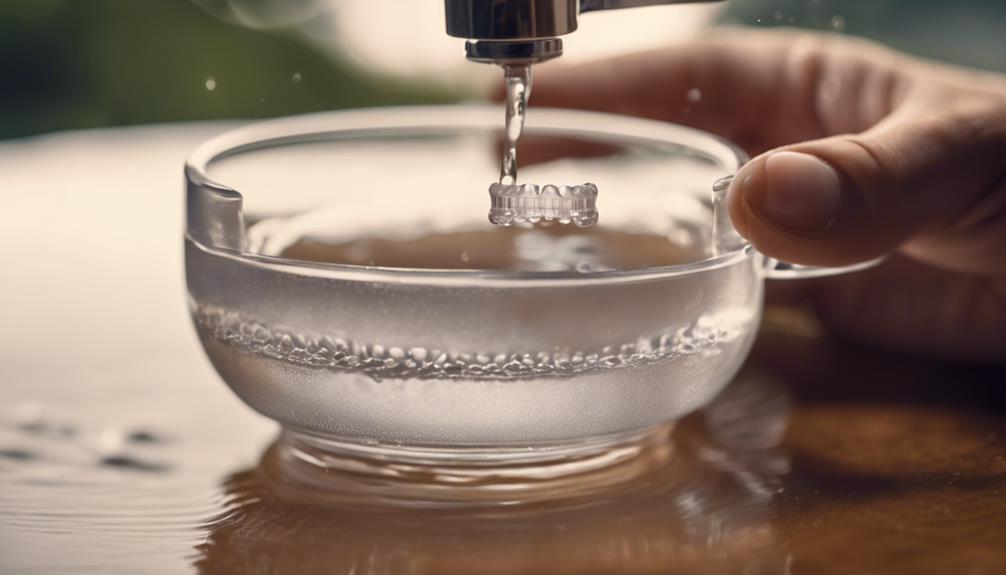
By rinsing your Invisalign trays with lukewarm water after enjoying your morning coffee, you're taking an important step in maintaining their appearance and preventing discoloration. Rinsing is essential because coffee residue can lead to plaque buildup on your Invisalign trays, which can cause staining and discoloration.
Regular rinsing helps remove staining agents from your aligners, ensuring they remain clear and invisible. Additionally, proper rinsing protects both your teeth and aligners from potential damage caused by coffee. Maintaining good oral hygiene includes rinsing your aligners after consuming coffee to prevent stains.
By doing so, you'll be able to enjoy your coffee while keeping your Invisalign trays in pristine condition. Remember, rinsing your Invisalign trays with lukewarm water after coffee consumption is a simple yet effective way to maintain their appearance and prevent discoloration.
Invisalign Food and Drink Guidelines

While you savor your morning coffee, it's important to understand the guidelines for consuming food and drinks while undergoing Invisalign treatment to guarantee the effectiveness and longevity of your aligners.
Drinking coffee while wearing Invisalign can lead to staining and damage to your trays. To secure the success of your treatment, it's vital to follow the guidelines for food and drink consumption.
Here are some key guidelines to keep in mind:
- Remove your Invisalign trays before drinking coffee to prevent staining and damage.
- Avoid drinking coffee with your Invisalign trays on, as it can discolor and warp your aligners.
- Drink coffee within a short time frame and rinse your mouth afterward to minimize the risk of staining.
- Regularly clean your Invisalign trays to maintain their appearance and effectiveness.
Enjoying Coffee With Invisalign Safely

Enjoying your morning coffee while wearing Invisalign requires you to take precautions to prevent damage or discoloration to your aligners. You can still enjoy beverages like coffee, but it's important to take extra steps to maintain your Invisalign trays.
To guarantee safe consumption, consider opting for iced or cold brew coffee, which is less likely to warp your aligners. When drinking hot coffee, use a straw to minimize contact between the liquid and your trays.
After consumption, rinse your mouth to remove sugar and bacteria, which can harm both your teeth and Invisalign trays. Additionally, brush your teeth and properly clean your Invisalign trays to prevent staining and maintain their appearance.
Frequently Asked Questions
What Happens if You Drink Coffee With Invisalign?
If you drink coffee with Invisalign, you're risking stains on both your aligners and teeth. Coffee's staining agents can discolor your clear aligners over time, and the heat from hot coffee can potentially warp your trays.
However, you can minimize the risk by choosing iced or cold brew coffee and properly cleaning and rinsing your aligners after consumption.
What Drinks Are OK With Invisalign?
Surprisingly, 70% of orthodontic patients don't follow their treatment plans correctly, which can lead to compromised results.
Now, regarding your question, what drinks are okay with Invisalign? The answer is straightforward: only water is recommended.
You should remove your Invisalign trays before consuming any other beverage to prevent staining and damage. Stick to clear water to maintain the effectiveness and aesthetics of your treatment.
Do Invisalign Attachments Stain With Coffee?
You're wondering if your Invisalign attachments will stain with coffee. The answer is yes, they can.
The tooth-colored attachments are porous, allowing coffee to seep in and cause discoloration over time. However, you can minimize the risk by rinsing your attachments with water after coffee consumption and avoiding excessive coffee intake.
Proper cleaning and maintenance can also help prevent staining.
Can You Drink Coffee With Clear Correct?
You're probably thinking, 'Coffee and Clear Correct aligners, a match made in heaven?'
Not quite. While you can drink coffee with Clear Correct, you should take precautions to prevent staining or warping. Remove your aligners or use a straw to minimize contact.
Rinsing your aligners after coffee consumption helps maintain their appearance. Opt for iced or cold brew coffee to reduce the risk of staining.
Conclusion
You've made it to the finish line! Remember, 'an ounce of prevention is worth a pound of cure.'
To enjoy coffee safely with Invisalign, prioritize removing your trays, opting for lukewarm or iced coffee, and rinsing your aligners thoroughly afterwards.
By following these guidelines, you'll guarantee a successful treatment while still savoring your daily cup.
Stay informed, and you'll be flashing a straight, coffee-stain-free smile in no time!
